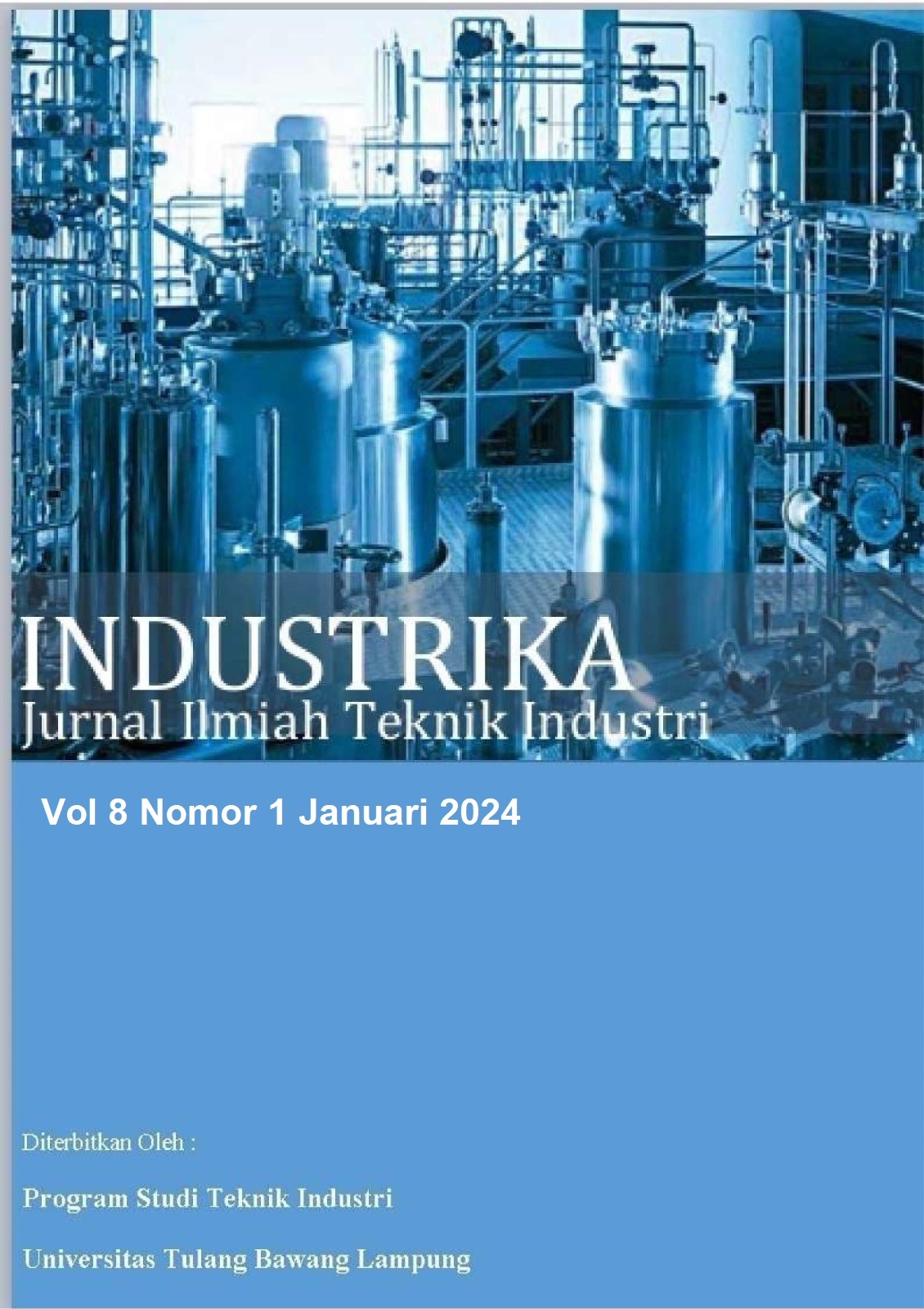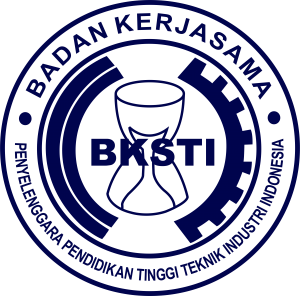Optimasi Parameter Pembuatan Genteng Keramik Pres Terhadap Respon Kuat Lentur dan Kuat Serap Air
DOI:
https://doi.org/10.37090/indstrk.v8i1.1348Abstract
Roof tiles are roof coverings that function to protect the lower part from the heat of the sun and rain. Roof tiles are usually made from earth, either pressed or printed and from cement. Good quality roof tiles do not leak easily, are neat when arranged, have a uniform size and shape, and do not break easily or become mossy. This research aims to determine the quality of roof tiles in terms of the parameters of strength against water seepage and strength to withstand bending loads. The results of calculating the signal-to-noise ratio for the strength to withstand the bending load of roof tiles from several variations of tests that have been carried out show that the A1 factor is 49.2469. To minimize the value of water absorption strength (%), a combination of level factors is needed, including a roller diameter (A) of 250 mm, engine rpm (B) of 1000 rpm, gap between rollers (C) of 3 mm, and material mixture ratio ( D) the mixture of ingredients used is kaolin: water: clay: sand is 0.35: 0:25. 1: 0.5. The optimal combination of factor levels, for both responses, the strength to withstand bending loads and the strength to resist water seepage, have the same maximum value (A3 B1 C3 D2), so there is no need to carry out a confirmation test. From the calculation of the signal-to-noise ratio for the strength to resist water seepage, it can be seen that the coefficient that responds is coefficient A1 is -25.4842.
Keywords: Ceramic tiles, Factors, Flexural strength, Level, Water absorption
Downloads
References
Agus Suyitno, Marsono, Y. (2021). Pemanfaatan Limbah Genteng Dengan Menggunakan Teknologi “ Mixer Machine” Bagi Pengusaha Genteng Di Kabupaten Trenggalek. JP2T, 2(2), 49–55.
Biomi, A. A., Haryawan, I. G. A., Prihastini, K. A., Luh, N., Aris, G., Negara, M., Adhyatma, M., & Kusuma, P. N. (2023). Sosialisasi Sikap Kerja Ergonomis Pada Pekerja Pembuatan Genteng Di Desa Darmasaba Badung_Bali. Comunity Development Journal, 4(2), 3643–3647.
Chen, H., Chang, S., & Tang, C. (2017). Application of the Taguchi Method for Optimizing the Process Parameters of Producing Lightweight Aggregates by Incorporating Tile Grinding Sludge with Reservoir Sediments. Materials, 10. https://doi.org/10.3390/ma10111294
Chin, C. L., & Ahmad, Z. A. (2019). Optimization of Ceramic Tile Properties from Three Malaysian Clays via Statistical Mixture Design. Arabian Journal for Science and Engineering, 0123456789. https://doi.org/10.1007/s13369-019-04150-9
Fajar Rizky Putranto, S. (2019). Pengaruh penambahan genteng press jatiwangi dan damdex terhadap kuat tekan beton 1,2. Jurnal Komposit, 3(1), 5–8.
Fauzi, F., Khanifa, S., Fisika, J., & Utara, U. S. (2016). Pemanfaatan Limbah Serat Ampas Tebu (Saccharum Officinarum) Sebagai Bahan Baku Genteng Elastis. Jurnal Teknologi Kimia Unimal, 2(November), 61–74.
Khairunisa, A., & Nurwandi, L. (2023). Usulan Perbaikan Proses Pembuatan Genteng dengan Menggunakan Metode Taguchi pada Home Industri Mahkota. Bandung Conference Series, 268–275.
Muhammad, K., Fatah, A., Yunus, M., Prasetyo, I., Muhammad, K., Fatah, A., Yunus, M., & Prasetyo, I. (2023). Analisis Kerusakan Mesin Molen Genteng Mengggunakan Metode Overall Equipment Effectiveness ( OEE ). JUSTIMES ( Jurnal Rekayasa Teknik Mesin Saburai), 01(01), 1–11.
Musabbikah, M., & Putro, S. (2017). Variasi Komposisi Bahan Genteng Soka Untuk Mendapatkan Daya Serap Air Yang Optima. Media Mesin: Majalah Teknik Mesin, 8(2), 1–6. https://doi.org/10.23917/mesin.v8i2.3102
Ni Putu Lisa Ernawatiningsih, Putu Wulandari, I. N. S. (2022). Meningkatkan Pmasaran Serta Produksi Pada UMKM Industri Genteng Di Masa Pademi Covid-19 Di UD.Sedana Nulus Desa Pejanten Kecamatan Kediri Kabupaten Tabanan. Prosiding Seminar Regional Pengabdian Kepada Masyarakat Universitas Mahasaraswati Denpasar, 1(1), 542–548.
Ni Putu Lita Nariani, Anis Raharjo, I. B. C. Y. (2021). Pembuatan Genteng di Desa Pejaten Dalam Fotografi Dokumenter 1,2,3. Retina Jurnal Fotografi, 1(2), 80–87.
Nugraha, A. S., & H, F. N. (2019). Plastic Waste Processing to Alternative Energy. ICCSET, 01, 428–433.
httpsss://doi.org/10.4108/eai.24-10-2018.2280579
Nugroho, A. S., Rahmad, Chamim, M., & Hidayah, F. N. (2018). Plastic waste as an alternative energy. AIP Conference Proceedings, 1977. https://doi.org/10.1063/1.5043022
Puja, I. K., & Sanjaya, W. (2021). KERAJINAN GENTENG PEJATEN SEBAGAI BENTUK USAHA. Jurnal Bakti Saraswati, 10(02), 198–204.
Pujiyanto, E., Rosyidi, C. N., Ibrahim, M. H., & Budiaji, A. (2022). Meningkatkan Kualitas Genteng Hasil Produksi IKM Kebakkramat Karanganyar untuk Memenuhi SNI 03-2095-1998. Jurnal Pengabdian Masyarakat Indonesia, 2(1), 25–31.
Rahayu, P. C., & Darvin, V. (2018). Quality Improvement On Ceramic Tiles Production Process With Six Sigma Method (DMAIC) AT PT Arwana Citramulia. Journal Industrial Manufacturing, 3(2), 101–110.
Riandari, E., Susetyo, J., & Asih, E. W. (2022). Pengendalian Kualitas Produksi Genteng Menggunakan Penerapan Metode Six Sigma dan Failure Mode and Effect Analysis (FMEA). Jurnal REKAVASI, 10(1), 64–71.
Subiyantoro, Aminudin Aziz, D. S. (2018). Peran Home Industri Genteng Terhadap Kehidupan Sosial Ekonomi Pengusaha Kecil Genteng. Jurnal Epicheirisi, 2(2), 1–4.
Susanto, H. (2021). Pemberdayaan Masyarakat Pengrajin Genteng Press Desa Embung Duduk Labulia Kabupaten Lombok Tengah. Seminar Nasional Pengabdian Kepada Masyarakat Universitas Terbuka.
Widodo, C. W. U. B. S. (2019). Analisis Penyebab Perubahan Dari Perajin Genteng Menjadi Perajin Batu Bata. UNESA.
Yusniyanti, E., & Irwansyah, A. (2019). Analisa Sifat Mekanik Genteng Komposit Polimer dari Penambahan Serat Panjang Sabut Kelapa. Proceeding Seminar Nasional Politeknik Negri Lhokseumawe, 3(1), 103–108.
Yusuf, M. (2020). Analisis Kualitas Produk Genteng Dengan Metode Taguchi. Akprind.
Downloads
Published
Issue
Section
License

This work is licensed under a Creative Commons Attribution-ShareAlike 4.0 International License.









